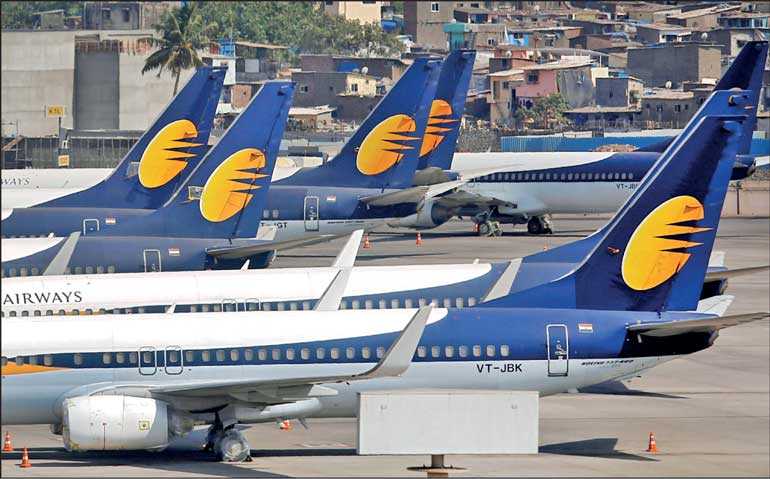Wednesday Jul 02, 2025
Wednesday Jul 02, 2025
Monday, 22 April 2019 00:00 - - {{hitsCtrl.values.hits}}

 Jet Airways of India, once the premier full-service carrier of the sub-continent, has ceased operations. “Jet Airways and its Board of Directors have been forced to take this extreme measure, as prolonged and sustained efforts with lenders and authorities to ensure the sustainability of the airline did not yield the desired results,” the company’s CEO Vinay Dube is quoted as saying, adding he is “hopeful that we will be able to bring the Joy of Flying back to you soon”.
Jet Airways of India, once the premier full-service carrier of the sub-continent, has ceased operations. “Jet Airways and its Board of Directors have been forced to take this extreme measure, as prolonged and sustained efforts with lenders and authorities to ensure the sustainability of the airline did not yield the desired results,” the company’s CEO Vinay Dube is quoted as saying, adding he is “hopeful that we will be able to bring the Joy of Flying back to you soon”.
Brave words from a beleaguered chief officer, but industry sources doubt that Jet (IATA code 9W, ICAO – JAI) will ever fly again. In fact, Jet’s principal rivals in India are feverishly raising capital in order to fill the void left by JAI. Vistara, a joint venture of India’s Tata Group and Singapore Airlines, raised $ 130 million recently to fund expansion. SpiceJet another domestic rival, has been raising cash too and has already announced plans to add 16 Boeing 737s and 10 turboprops to its fleet at very short notice.
A short history
Jet Airways was the brainchild of its founder, the genial Naresh Goyal, who grew a small travel agency into an airline with over 100 aircraft and a network stretching from India to the USA. First operations were in 1993 and within a year JAI was the second largest private airline in India. International operations were added in 2004, with Colombo being the first overseas destination. London was added in 2005 and by 2010 Jet was the largest airline in India with a market share of 22.6%.
What happened?
Jet’s initial dominance of India’s huge market was never going to live long. With the entrance of SpiceJet in 2004 and Indigo Airlines in 2006, both using the Low Cost Carrier (LCC) business model, the airspace became crowded. AirAsia India, an associate of Tony Fernandes’ AirAsia Group based in Malaysia, also entered the fray in 2014 followed by Vistara in 2015, further fragmenting the market. Interestingly both these businesses are joint ventures of the Tata Group, founded by the legendary J.R.D. Tata who also founded Air India in the 1930s.
Jet began an ambitious expansion program with the purchase of Air Sahara in 2007, which was renamed JetLite a LCC. In March 2012, with the demise of Kingfisher Airlines, Jet began to offer a premium cabin on its domestic flights and JetLite was merged with the parent. By December 2014, JAI had morphed into a full-service carrier, India’s third with state-owned Air India and Tata group’s Vistara being the other two.
By 2012 Jet’s fleet crossed the 100 mark, peaking at 116 aircraft in 2016, which is also the only year in the past decade that the airline made a profit. The airline also has a huge order book, with over 200 Boeing 737s and 10 Boeing 787s in the pipeline, signalling a complete renewal of its fleet.
Etihad Airways of Abu Dhabi bought a stake in JAI in late 2013. After this, Jet entered into a price-war with Indigo and SpiceJet in an effort to gain market share.
Low fares and high costs
The fare war signalled the beginning of the endgame. Indigo and SpiceJet, both very focussed LCCs, were able to control their costs effectively and raise equity capital.
Forced to increase its debts in order to keep in competition as it burned through cash reserves, JAI was burdened with over a billion USD in debt by the end of the last financial year. This, coupled with increasing fuel prices and significant maintenance costs, deeply affected Jet’s finances.
A sprawling network, an expensive full-service business model and a diverse fleet (with Airbus, ATR and Boeing types) meant that JAI was not able to streamline its operations and stay cost-competitive with the LCCs in the domestic space. Yet, JAI continued the price war and in the process focused on growing its load factor, rather than raising fare levels. The price-focussed Indian passenger wanted the cheapest fares possible and delivering this, while watching costs spiralling out of control, meant that the writing was on the wall.
Meanwhile the giant Gulf carriers, with their ‘mega-hubs’, flawless service and deep pockets, meant that the long-haul market too was also under severe pressure. This double blow was too much for Jet’s finances to bear and in March of this year the airline was forced to ground aircraft and suspend international operations.
Founder Goyal and his family continue to hold a majority stake of the company on paper, but in principle have exited the company a few weeks ago, with lenders holding a majority share in the company in return for equity. An Expression of Interest document was issued by the lead lender State Bank of India for ‘Change in Control and Management of Jet Airways (India) Limited’ on 8 April.
Whether any investors will step forward to purchase the now defunct airline remains to be seen. But if any lesson is to be learned from the sad demise of Jet Airways, it is that in this rapidly evolving market with largely unfettered capacity increases, laser-like control of costs and safeguarding a strong revenue base are both essential to ensure survival.
As Charles Darwin put it many years ago, “It is not the strongest of the species that survives, nor the most intelligent that survives. It is the one most adaptable to change.”
Discover Kapruka, the leading online shopping platform in Sri Lanka, where you can conveniently send Gifts and Flowers to your loved ones for any event including Valentine ’s Day. Explore a wide range of popular Shopping Categories on Kapruka, including Toys, Groceries, Electronics, Birthday Cakes, Fruits, Chocolates, Flower Bouquets, Clothing, Watches, Lingerie, Gift Sets and Jewellery. Also if you’re interested in selling with Kapruka, Partner Central by Kapruka is the best solution to start with. Moreover, through Kapruka Global Shop, you can also enjoy the convenience of purchasing products from renowned platforms like Amazon and eBay and have them delivered to Sri Lanka.
Discover Kapruka, the leading online shopping platform in Sri Lanka, where you can conveniently send Gifts and Flowers to your loved ones for any event including Valentine ’s Day. Explore a wide range of popular Shopping Categories on Kapruka, including Toys, Groceries, Electronics, Birthday Cakes, Fruits, Chocolates, Flower Bouquets, Clothing, Watches, Lingerie, Gift Sets and Jewellery. Also if you’re interested in selling with Kapruka, Partner Central by Kapruka is the best solution to start with. Moreover, through Kapruka Global Shop, you can also enjoy the convenience of purchasing products from renowned platforms like Amazon and eBay and have them delivered to Sri Lanka.